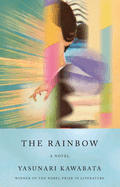
Rainbows are beautiful, but they don't stick around for long. This concept of impermanence is at the heart of The Rainbow, a 1951 novel by Japanese Nobel Prize laureate Yasunari Kawabata (Dandelions). Translated by Haydn Trowell, it's available in an English translation for the first time. The story, set shortly after World War II, is one of two stepsisters born to the same father. Asako, the younger sibling, has recently traveled to Kyōto from Tokyo after having learned of a third stepsister. Momoko, the elder, dates lots of men, partly out of grief over her lover who died in the war. Their father, Mizuhara, is an architect who remodels former nobles' homes that have been turned into inns and restaurants, a change that has prompted him to doubt whether modern architecture "would endure as a testament to beauty." He also wonders: Are "the fates of architects... now at the mercy of the destructive power of the atomic bomb?"
Kawabata evokes the trauma of a Japan still reeling from the war and left to ponder the transitory nature of existence and the country's standing in the world. On a train ride, Asako sees a rare winter rainbow above a lake "as though it were floating in midair." That's one of many fleeting treasures--the relatively trivial rainbows and cherry blossoms as well as the more life-and-death moments--that Kawabata contemplates in this melancholy work. The prose and some of the attitudes are old-fashioned, but the cry for healing and tolerance is as timely as ever. --Michael Magras, freelance book reviewer

